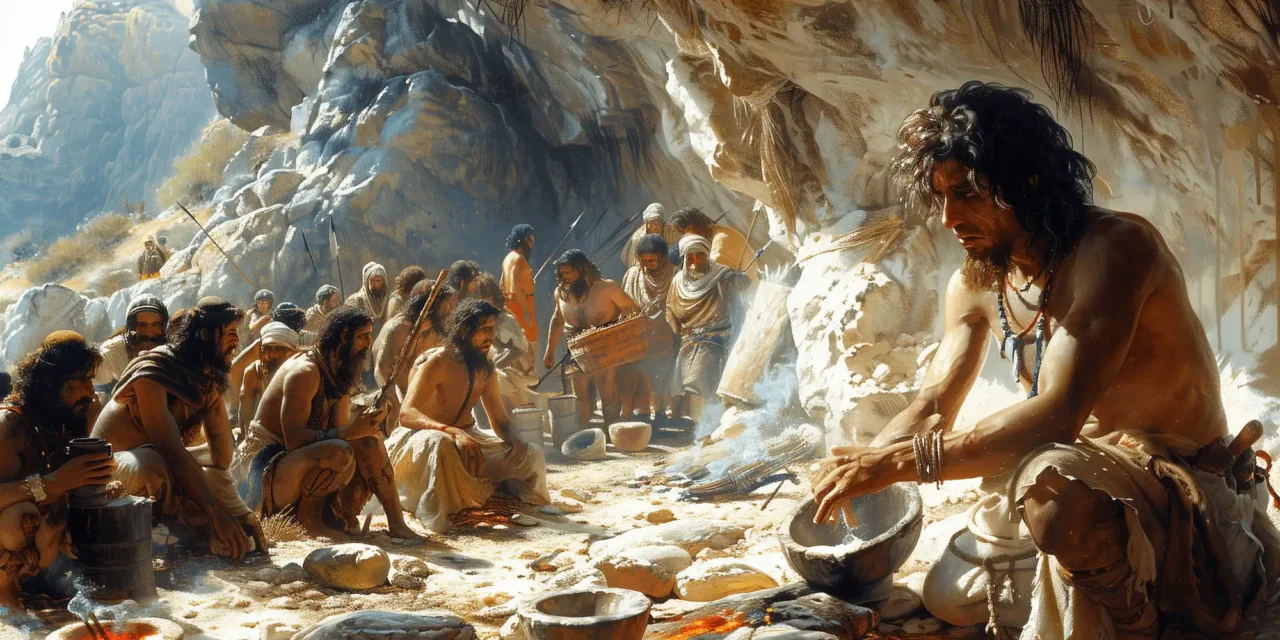Until recently, it was widely accepted that beer brewing and wine production started with the civilizations of Mesopotamia and Egypt, documented by literary and iconography. Kind of like a tale much older than Noah getting tipsy with his grape juice. But scholars have had to get their Sherlock Holmes hats on in recent years and turn the clock back even further. The starting point to produce alcoholic beverages has been pushed further into the past.
Beer is truly a magical beverage. Not only does it taste great, but it also lasts longer than other cereal products, thanks to its lack of oxygen and low pH. It’s like the superman of cereal products.
At first glance, the notion of early evidence for alcohol consumption might make you do a double take. Yet if you take a step back and take a closer look, it all starts to make sense – it’s like the missing puzzle piece to the picture of how the transition from a hunting and gathering society to an early village-farming community came to be. It was all about creating a social environment that incentivized food production. A nice cold brew after a hard day’s work may have been just the thing that made the shift from the stone age to the agricultural age a bit more palatable.
Feasting has long been like a party that the Epipaleolithic and early Neolithic societies couldn’t wait to plan – and for a good reason. After all, who doesn’t love a good feast? They needed to prepare a massive spread of delicious dishes and, of course, a variety of drinks – usually with a healthy dose of alcohol. It was like their version of a dinner and a show.
New food sources and processing techniques were explored like a kid in a candy store! In response to the demand, religious beliefs and practices may have been a key factor in the adoption of intensive cultivation and the transition to agriculture.
Raising a Glass to the Ancient Brewmasters: A Toast to the Natufians
Researchers have uncovered what they believe to be the world’s oldest brewery, a beer-making establishment so ancient it could have served patrons in the days of the pyramids! The find was made while studying a burial site for semi-nomadic hunter-gatherers near Haifa, Israel. An international team of scientists discovered and tested residue from the mortars used by the Natufians and found a 13,000-year-old beer recipe in the Raqefet Cave in the Carmel Mountains. The find is being hailed as a major breakthrough in understanding the habits and customs of these ancient people, who could now finally be considered the original party animals! They were clearly brewing up something special in their prehistoric pub, and it’s a discovery that could make even the most seasoned beer connoisseur raise a glass in admiration.
The findings also suggest that beer wasn’t just a necessary sidekick of making bread like a loyal sidekick accompanying the hero on his journey, as was previously thought. Through diligent detective work, including laboratory analysis, consulting other archaeological evidence found in the cave, and carefully examining the wear of the stones, the team discovered that the ancient Natufians used ingredients from seven plant families, “including wheat or barley, oat, legumes and bast fibers – a recipe which definitely could have brewed a beer of mythical proportions.
After laboratory analysis, the team hypothesized that the Natufian brewery used a three-stage process, much like baking a cake! The first step was preparing the malt, which was like prepping the batter—made from the starch of wheat or barley through grain germination. Next, they matted the malted grain, similar to mixing the ingredients together. Finally, they added the magic ingredient – fermentation from wild yeast – much like adding the secret ingredient to your favorite recipe.
The Sumerian Beer Revolution: Let’s Beer and be Merry
At least 4,000 years ago, in Mesopotamia, the party scene was hopping! Archaeologists have uncovered ample evidence that the Sumerians were the real beer connoisseurs of the ancient world. You could say that for them, beer was the ultimate ‘liquid gold.’ Over time, their taste for beer has been proven to have surpassed even their appetite for wine and other fermented drinks, making them true ale experts.
Some of the ancient art from Sumer sends us a clear message: beer was life! Depictions of people drinking with long straws around a large vessel give the impression of a giant keg party as if they were shouting, “Hooray! Let’s beer and be merry!” Indeed, beer was a symbol of hospitality and community among the Sumerian people. And the most familiar crest engraved over cities, everywhere, was the one representing beer, with roughly-drawn lines within the jar shape ala a tap. That’s the kind of symbol that really makes you thirsty.
Using a standard chemical test, Dr. McGovern and Dr. Michel determined that the residue contained calcium oxalate, a major component of the material that settles out at the bottom of brewery vats and storage tanks and is characteristic of barley beer.
It’s a real conundrum: which came first, the chicken or the egg? But don’t worry. Historians have tried to crack this case, and it looks like beer won the day! It’s thought that after people domesticated barley in early Mesopotamian times, around 8000 BC, they had an even better idea: let’s turn this grain into some delicious beer, and cheers to agriculture! So, beer could actually be one of mankind’s oldest inventions, and it seems like humans were quick to find the silver lining to their newfound farming abilities. We should be thankful for our ancestors’ creativity because, without beer, life wouldn’t be worth drinking.
One of the earliest examples of writing features two fundamental human concerns: alcohol and work.
It’s like the ancient people of Uruk were leaving a clue for future generations right here in the sands of Iraq – a kind of paper trail of bread and brewed happiness! Archaeologists believe that this primitive cuneiform tablet was a token of the glory days of Uruk when the people enjoyed a large ration of delicious beer.
Scattered around this area are scratch marks, like hieroglyphics from a lost civilization, which record the sudsy wages of a certain commissioned beverage server. It’s the oldest pay slip known to humankind, suggesting that the concept of employer and employee was no stranger to us even five thousand years ago.
Ancient Brews and Bonding: Keeping Spirits & Society Together
Stone Age farmers weren’t just looking to fill their bellies — they were yearning to lighten their load and lift their spirits! Instead of wolfing down a bowl of cereal (like we do today), they figured out how to use those kernels to craft a beer that would have them floating on clouds. It’s like they discovered the magical properties of grains much earlier than us, but they took it one step further and enjoyed a heavenly brew, unlike anything we know today.
It’s like people went to extreme lengths to get their hands on grains like they were priceless diamonds. They knew it would take a lot of hard work to turn these grains into a yummy beer, but they wouldn’t let that stop them. It’s almost like they were saying, “let the feast begin!” because they knew that these gatherings were fun and a way to connect with each other.
Grains have always been like man’s best friend- they’ve been there to help us out in hard times, particularly when it comes to feasts. Beer has been the “cherry on top” of this relationship, providing us with an amazing experience that was worth all the hard work of preparing the grains.
Feasts are like the glue that holds traditional societies together! They create bonds between people, forming alliances and debt-forgiveness among community members, and create powerful political and social networks that provide a strong foundation for even more complex societies.
Humans have been brewing alcohol for quite a while! It all started back in Neolithic times in China and Sudan – like a fine, aged wine, the beer-making tradition was passed down through generations letting it ferment and evolve. Soon, it could be found being brewed in the first pottery in Greece – and if rumors are to be believed, it even accompanied the discovery of maize.
From Sumer to Sumptuous: The Jam-Packed Journey of Beer
Hopping back in time to ancient Egypt, Babylon, and Sumerian days, it goes without saying that beer was the beverage of choice. After all, it was like their ‘liquid gold’! Not only was it a tasty refreshment, but it was surprisingly easy to make as it could be brewed with just wheat and barley.
In Mesopotamia, they used to reserve between a third and half of the harvest to produce a delightful amber-colored beverage that would leave the consumer with a feeling of warmth and comfort. The ancient producers kept the malt to make this delicious brew by baking it to make something like a magical flatbread-a-porter that acts like a key to the beer-making underworld. Just dunk this “open-sesame” bread into the water to unlock a bubbly, frothy brew that would make even King Gilgamesh secretly tap his feet with glee.
The methods and techniques to make beer traveled from the Middle East to Western and North Europe.
In North Europe, the incredibly popular beverage (the one I’m talking about) is quite the conundrum. The accepted theories as to why it’s so popular are plentiful, but the most popular explanation is that making wine was a bit of a challenge for the folks of North Europe. So, rather than stay thirsty, they opted to make the most of the resources they had and created something that went down a treat in spite of its minimalistic ingredients.
Beer is the people’s beverage; the working class has been by our side for centuries. In some ways, it has been the energy drink of our laborers and artisans; the fuel to get them through the hard graft of the day. Wine, however, has always had a more aristocratic air — the fine tipple of the upper classes; reserved for the more leisurely life of the well-to-do.
From Germanic to English: The Genesis of Beer
In early forms of English and Scandinavian languages, the usual word for beer was the word whose Modern English form is ale.
The word beer comes into present-day English from Old English bēor, itself from Common Germanic;. However, the term is not attested in the East Germanic branch of the language family. It is found throughout the West Germanic and North Germanic dialects.
In Old English and Old Norse, the word beer did not denote a malted alcoholic drink like an ale but a sweet, potent drink made from honey and the juice of one or more fruits other than grapes.




